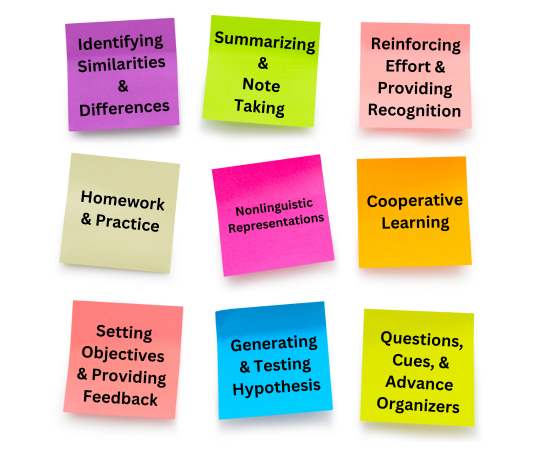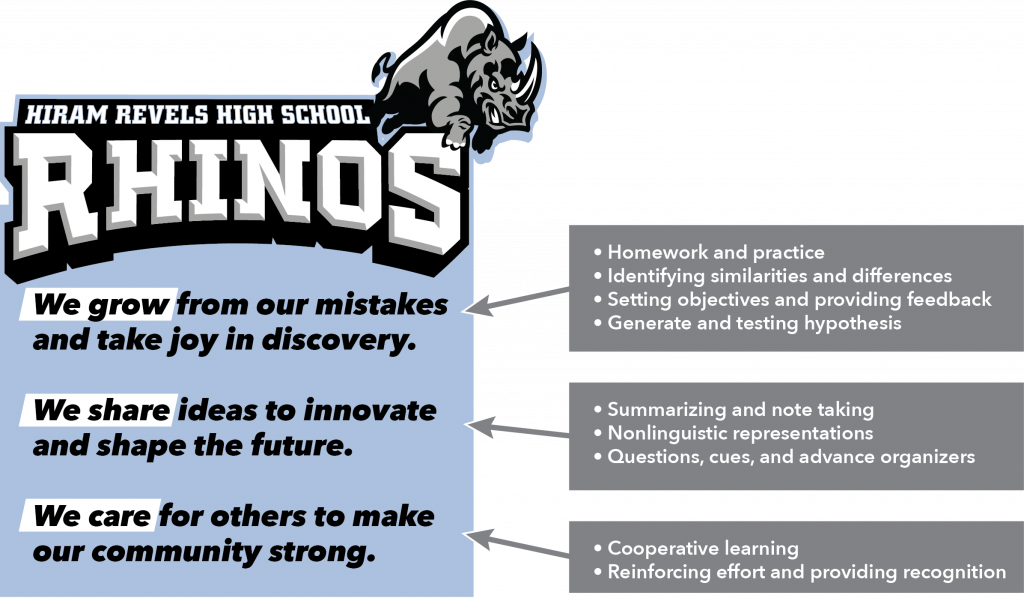Marzano’s Strategies & Contextualizing Approaches to Learning in Shared Language for Student Outcomes

This chart lists high-yield instructional strategies, what the research says about them, and how to implement them in classrooms. The information has been adapted from Classroom Instruction that Works: Research-based Strategies for Increasing Student Achievement by Robert Marzano.
Many times, educators are given tactics or strategies to transform their practices. These approaches are often based on research or best practices, and have been shown to work in other schools or classrooms. Trying new approaches requires teachers to find ways to incorporate them into their existing curriculum and style of teaching. Even when these resources come with examples, they may or may not resonate with teachers who are considering these practices.
Schools that have a clear shared understanding of their identity can use this identity to connect or ground new approaches in terms of already understood and accepted outcomes or goals. Based on our work with over 100 schools in the past 5 years, we find that a shared vision for readiness is the most useful, tangible, and authentic statement of a school’s identity. These statements of identity can also include a description of shared values and beliefs or a postsecondary readiness definition.
This simplifies the process of adoption for teachers and provides students with language to understand the new strategies they are learning.
Take for example, Marzano’s high-yield instructional strategies. These are an excellent resource for schools who are looking to improve student capacity for learning and are based on research that has shown their effectiveness.
Taken individually, each of these strategies could be used by a teacher to improve instructions in the classroom. See this example of a typical way that Marzano’s strategies are presented to educators.

Marzano’s strategies provide an excellent resource for schools who are looking to improve student capacity for learning.
Marzano’s Strategies
This chart lists high-yield instructional strategies, what the research says about them, and how to implement them in classrooms. The information has been adapted from Classroom Instruction that Works: Research-based Strategies for Increasing Student Achievement by Robert Marzano.
Based on our work around the Inflexion Approach, we believe that supporting student learning empowers readiness for all students, particularly when there are structures in place to support that learning and the school has a shared definition of what readiness for all students means.
However, consider that teachers also may be trying to incorporate not just Marzano’s strategies, but also perhaps the 4cs (collaboration, critical thinking, creativity, and communication), social-emotional learning, or any of the other valuable but sometimes challenging-to-adopt approaches to learning.
A school’s identity and its vision for readiness should be the anchors from which all decisions related to structures and learning approaches are made. Without those anchors, schools will continue to suffer from incoherent, sporadic, and unsustainable attempts at system-level improvement.
By framing the strategies in the context of existing language around student outcomes, teachers can avoid some elements of the initiative fatigue that are so common. School leaders who want to share strategies with teachers could consider framing them in the context of student outcomes to simplify adoption.
For example, a school that has statements of identity that represent a holistic vision for student readiness can have room to serve as an umbrella for many new initiatives and bring cohesiveness to the different efforts.

When a teacher helps make explicit connections to shared values for students, an instructional strategy can go far beyond simply practicing knowledge and skills and can be transformed into an opportunity to reinforce a school’s identity, strengthen its culture, and enhance educational equity for students traditionally marginalized in public schools.
Stay in the Loop
Subscribe to Our Newsletter
This work by Inflexion is licensed under Creative Commons Attribution-NonCommercial-ShareAlike 4.0 International







Responses